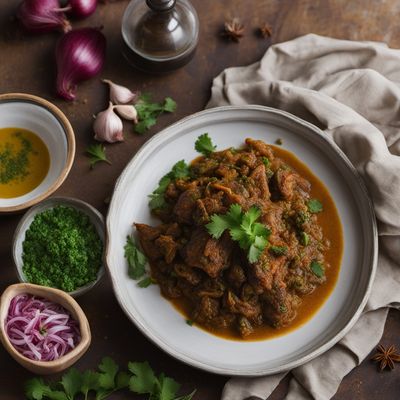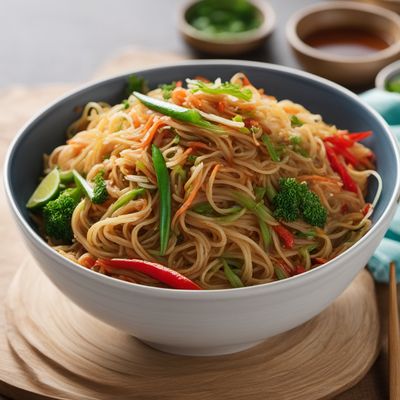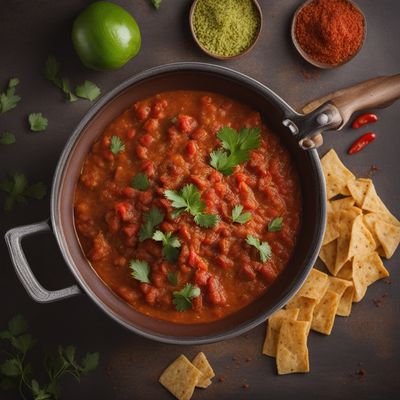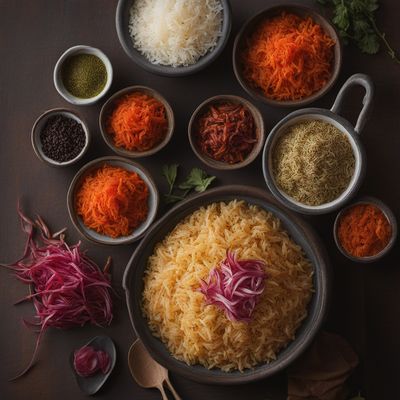
Cuisine
Djiboutian cuisine
Djiboutian cuisine is a reflection of the country's history and culture, with influences from Africa, the Middle East, and France. The cuisine is known for its use of spices, grains, and legumes, as well as its emphasis on fresh ingredients. The dishes are often hearty and filling, with a mix of sweet, savory, and spicy flavors.
Typical ingredients
Grains (such as rice and couscous), Legumes (such as lentils and chickpeas), Vegetables (such as okra, eggplant, spinach), Meat (such as beef, goat, chicken), Fish, Tomatoes, Onions, Garlic, Ginger, Chili peppers, Coriander, Cumin, Cardamom, Turmeric
Presentation and garnishing
Dishes are often served family-style, with large platters of food being placed in the center of the table. Garnishes may include fresh herbs, sliced fruits, or grated coconut.
Djiboutian cuisine is known for its use of shah, a traditional tea made with spices and sugar.
More cuisines from this region...
Ethiopian cuisine, Kenyan cuisine, Tanzanian cuisine, Eritrean cuisine, Rwandan cuisine, Somali cuisine, Ugandan cuisine, Maasai cuisine, Burundian cuisine, South Sudanese cuisine
History
The history of Djiboutian cuisine is closely tied to the region's trade routes, which brought spices, grains, and other ingredients from the Middle East and France. The cuisine has evolved over time, with each country in the region developing its own unique dishes and flavors. However, there are many commonalities between the cuisines of the Horn of Africa, including the use of spices, grains, and legumes.
Cultural significance
Food is an important part of the culture in Djibouti, with many traditional dishes being served during special occasions and celebrations. The cuisine is also influenced by the country's religious beliefs, with many dishes being prepared for specific religious holidays.
Health benefits and considerations
The cuisine of Djibouti is generally healthy, with an emphasis on fresh ingredients and vegetables. However, some dishes may be high in fat or sodium due to the use of coconut milk and salt.
Djiboutian cuisine dishes
Djiboutian cuisine recipes Browse all »

En Vessie Djiboutian Style
Savory Djiboutian Delight: En Vessie with a Local Twist

Djiboutian Spiced Seafood Stew
Savory Seafood Delight: Djiboutian Spiced Seafood Stew

Djiboutian-style Chicken in Yellow Wine Sauce
Savory Djiboutian Chicken Delight: A Burst of Flavors in Yellow Wine Sauce

Djiboutian-Inspired Sotanghon Stir-Fry
Savory Djiboutian Sotanghon Delight

Djiboutian-inspired Stuffed Pastry Rolls
Savory Delights: Djiboutian-inspired Stuffed Pastry Rolls

Djiboutian-inspired Halušky with Spiced Lamb
Savory Lamb Halušky: A Djiboutian Twist on a Slovak Classic

Djiboutian Spiced Riganada
Savory Djiboutian Delight: Spiced Riganada with a Twist

Djiboutian Spiced Garlic Sausage
Savory Djiboutian Delight: Spiced Garlic Sausage

Grilled Sardines with Djiboutian Flavors
Savory Delights from the Sea: Djiboutian Grilled Sardines

Bigoli in Salsa with a Djiboutian Twist
Savory Djiboutian Bigoli in Salsa: A Fusion of Italian and East African Flavors

Djiboutian-style Stuffed Paratha
Savory Delight: Djiboutian Stuffed Paratha with a Spicy Twist

Djiboutian Spiced Rice with Fermented Vegetables
Savory Djiboutian Rice Delight with Tangy Fermented Vegetables
